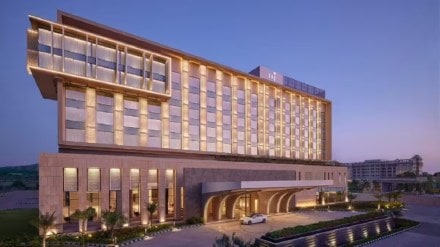The hotel industry is expected to report a 7-9 per cent revenue growth in FY2025, over the 14-16 per cent growth estimated for FY2024, said ICRA. Sustenance of domestic leisure travel, demand from meetings, incentives, conferences, and exhibitions (MICE), including weddings and business travel (despite a temporary lull during the election period), are likely to drive demand in FY2025, it stated. Spiritual tourism and tier-II cities are also expected to contribute meaningfully in FY2025.
Per the report by ICRA, domestic tourism has been the prime demand driver in FY2024 and is likely to remain so in the near term. Foreign Tourist Arrivals (FTA) are yet to recover to pre-Covid levels and the improvement would depend on the global macroeconomic environment.
ICRA estimates pan-India premium hotel occupancy at decadal highs of ~70-72 per cent in FY2024 and FY2025, after recovering to 68-70 per cent in FY2023. Pan-India premium hotel average room rates (ARRs) are expected to go up to ~Rs 7,200- Rs 7,400 in FY2024 and rise further to Rs 7,800- Rs 8,000 in FY2025. The RevPAR, meanwhile, is expected to be at an 8-12 per cent discount to the FY2008 peak in FY2024 and subsequently converge towards the FY2008 peak in FY2025. However, the spike in ARR in some hotels and specific pockets has been higher than the average levels, with a few outliers even crossing the FY2008 peak in FY2024.
The demand outlook over the medium term remains healthy, supported by a confluence of factors, including improvement in infrastructure and air connectivity, favourable demographics, and anticipated growth in large-scale MICE events with the opening of multiple new convention centres in the last few years, among others. And the healthy demand amid relatively lower supply would lead to higher ARRs. Several hotels are also undergoing renovation, refurbishment, and upgradation, and these are likely to support the ARRs further, going forward. Larger players would also benefit from revenues/share of profits generated from hotel expansions through management contracts and operating leases.
Vinutaa S, Vice President and Sector Head – Corporate Ratings, ICRA Limited, said, “Demand is expected to remain strong across markets in FY2025 as consumer sentiments continue to be healthy and corporate performance is stable. Hotel-specific demand would, however, depend on location, competition, and other property-related dynamics. Further, domestic tourism would be the prime driver, with FTA improvement depending on the global macroeconomic environment. Mumbai and NCR, being gateway cities, are likely to report occupancy north of 75 per cent in FY2024 and FY2025, benefitting from transient passengers, business travellers and MICE events. The ARRs would witness a healthy YoY increase in FY2024 and FY2025 across markets. This sharp rise in ARRs of premium hotels also resulted in the spillover of demand to mid-scale hotels.”
Sustenance of a large part of the cost-rationalisation measures undertaken during the Covid period, along with operating leverage benefits, has resulted in the sharp expansion in margins compared to pre-Covid levels. The staff-to-room ratio remains ~15-20 per cent lower than the pre-Covid levels. Companies have increased their usage of renewable power while pass-through of the cost inflation and strict control on fixed cost increase have also supported margins. Asset-light expansions have been margin-accretive for larger hotel chains.
ICRA’s sample comprising 12 large hotel companies is expected to report strong operating margins of 31-33 per cent for FY2024 and FY2025, against 33 per cent for FY2023 and 20-22 per cent pre-Covid. However, within the sample, it is likely to be a mixed bag, depending to a certain extent on renovations and increase in employee expenses amidst growing demand. De-leveraging of balance sheets has led to lower interest costs and would support net margins, it said.
ICRA expects the uptick in earnings and cash flows to support the capital structure going forward. Debt metrics are expected to be better than pre-Covid levels in FY2024 and are likely to improve further in FY2025. The extent of improvement in return on capital employed (RoCE) would, however, depend on the expansion strategy and could be constrained by the high capital cost of new properties owing to increased land and construction costs in case of asset-heavy expansion. The healthy business accruals have led to improvement in credit profiles in several companies, resulting in upgrades significantly exceeding downgrades in FY2023 and 10M FY2024.
“The healthy demand uptick has resulted in a pick-up in supply announcements and commencement of deferred projects in the last 18-24 months. The premium supply pipeline for FY2024-FY2026 has increased by 25-30 per cent compared to that anticipated for the same period a year ago because of fresh signings and announcements. Several global brands have made their entry into India. However, supply, which is expected to grow at a CAGR of 4.5-5 per cent over the medium term, would lag demand. Compared to the downcycle in FY2009, which saw untimely supply increases of over 15 per cent of the inventory at the bottom of the cycle during FY2009-2013, the current low inventory growth is expected to support the upcycle as demand improves over the medium term,” Vinutaa S added.
A large part of the new supply is through management contracts and operating leases. Land availability issues currently constrain supply addition in the premium micro-markets in metros and larger cities. Sizeable supply announcements are seen in tier-II leisure, business, and religious destinations. There is also an increase in per-room construction cost by 20-25 per cent, with cost inflation, compared to pre-Covid levels.
